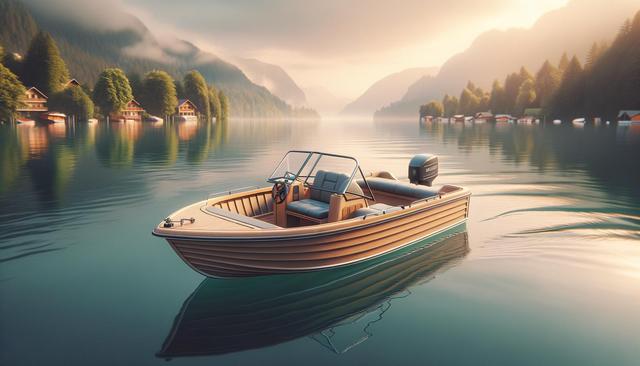Why Choose a Small Electric Boat for Lake Use?
Small electric boats are becoming increasingly popular for lake enthusiasts seeking a quiet, eco-conscious way to explore calm waters. Unlike gas-powered models, electric boats produce no emissions, operate with minimal noise, and require less maintenance overall. These features make them especially well-suited for lakes, where environmental preservation and noise control are often priorities. Whether you’re fishing, birdwatching, or simply enjoying a peaceful ride, electric boats offer a gentle footprint on natural ecosystems.
One of the main benefits of these boats is their simplicity. Most small electric boats are easy to operate, making them accessible even for those with limited boating experience. Their compact size allows for easier storage and transportation, and many models can be launched from smaller docks or even directly from trailers. Additionally, the use of rechargeable batteries means ongoing fuel costs are significantly reduced, and charging can be done at home or at dedicated marina stations.
Design Features and Seating Capacity
Most small electric boats designed for lakes offer a minimalist yet functional design. They typically accommodate between two to four passengers, depending on the size and build. The seating is often arranged to maximize space while ensuring comfort during extended trips across the water. Some models include cushioned bench seating, while others may feature individual seats with back support.
Key design elements of these boats include:
- Lightweight hulls made from materials like fiberglass or high-density polyethylene
- Integrated battery compartments for weight balance and safety
- Flat or semi-V hull designs for stable performance on calm waters
- Optional features such as sun canopies, rod holders, or small storage compartments
These boats are not built for speed, but rather for steady, smooth cruising, which aligns well with recreational lake use. Their compact design also means you can navigate through narrow inlets or shallow waters where larger boats might struggle.
Power Systems and Battery Life
The heart of any electric boat is its power system. Small electric boats for lakes typically use lithium-ion or AGM (Absorbent Glass Mat) batteries, both of which are known for reliability and long service life. Battery capacity can vary between models, but most support several hours of continuous operation on a single charge, which is more than sufficient for a leisurely day on the water.
Charging these batteries is often straightforward. Depending on the boat, you can plug the system into a standard electrical outlet or use solar charging setups for added sustainability. Charging times vary but usually fall within a 4 to 10-hour range. Some boats come with battery management systems that help monitor usage and optimize charging efficiency.
When considering a small electric boat, it’s worth checking the motor’s thrust rating. This will give you a better idea of how well the boat can handle slight currents or winds that may occur on larger lakes. While not intended for high performance, these motors are generally more than adequate for calm water navigation and light towing tasks like pulling a small dinghy or float.
Use Cases: Fishing, Recreation, and Eco-Touring
From solo fishing trips to leisurely family outings, small electric boats serve a wide range of recreational purposes. Anglers appreciate their quiet motors, which allow them to approach fish-rich areas without causing disruption. Many fishing-friendly models come equipped with mounting points for trolling motors and fish finders, increasing their utility on the water.
For those more interested in relaxation, electric boats provide a serene platform to enjoy nature without the background hum of a gas engine. Their slow cruising speed encourages mindfulness and offers opportunities to observe wildlife, take photos, or simply unwind. Eco-tourism operators are also beginning to incorporate electric boats into their fleets for guided lake tours, thanks to their low noise and zero-emission characteristics.
Popular use cases include:
- Morning or sunset cruises
- Birdwatching excursions
- Picnicking on the water
- Eco-friendly sightseeing tours
These applications highlight the versatility of small electric boats and their alignment with low-impact recreational activities.
Maintenance and Long-Term Considerations
One of the standout advantages of small electric boats is their low maintenance profile. Without internal combustion engines, there are fewer components prone to wear and tear. Routine tasks generally include battery upkeep, occasional cleaning of the hull, and checking electrical connections. This makes them a practical choice for those who want more time on the water and less time in the workshop.
Over the long term, it’s important to consider battery replacement as part of ownership. Most modern marine batteries last between 3 to 7 years, depending on usage and charging habits. Replacements can be a significant cost, but they’re infrequent and predictable. Proper storage during off-season months can also extend the life of both the battery and the boat itself.
For those who enjoy customizing their vessels, many electric boats allow for modest modifications. You can add accessories like extra seating, navigation lights, or solar panels, depending on your needs. Just be cautious not to overload the boat, as weight and balance are crucial for maintaining safety and efficiency.
Conclusion: A Quiet, Eco-Friendly Choice for Lake Enthusiasts
Small electric boats offer a compelling option for anyone looking to enjoy lakes without disturbing their natural beauty. Whether you’re drawn to fishing, photography, or simple relaxation, these boats provide a sustainable and user-friendly way to experience the water. Their silent operation, easy maintenance, and environmentally friendly design make them a thoughtful choice for lake lovers who value both performance and preservation.


